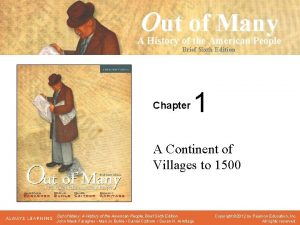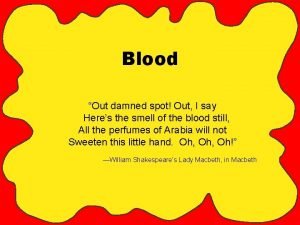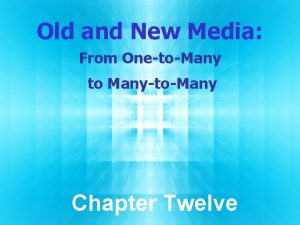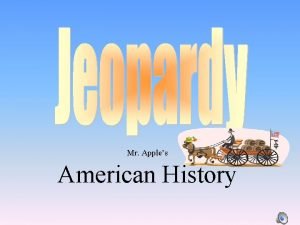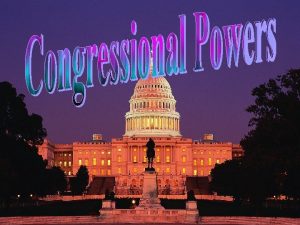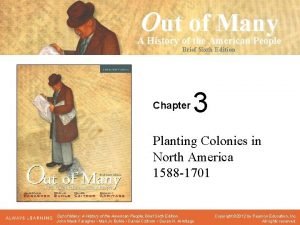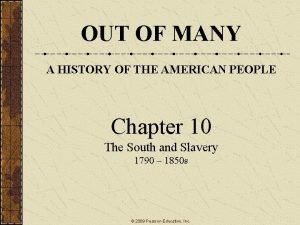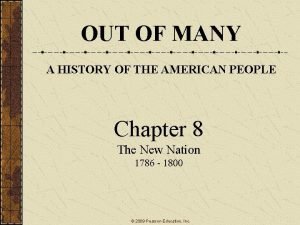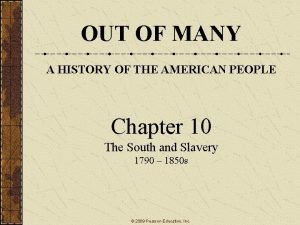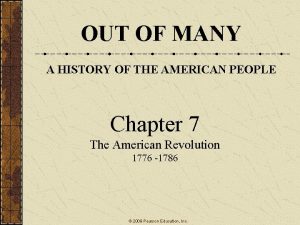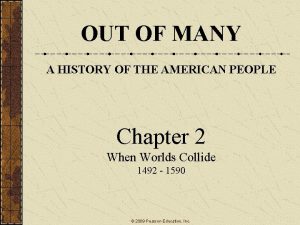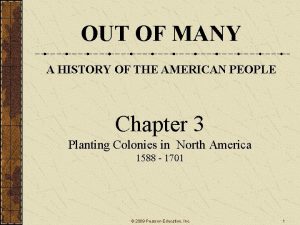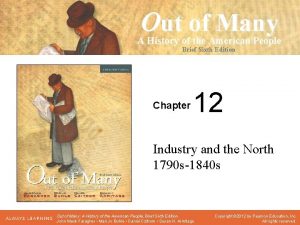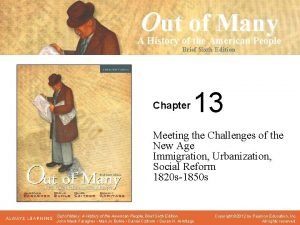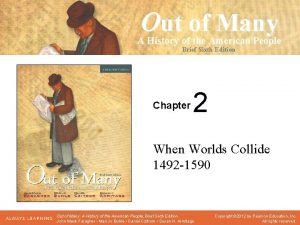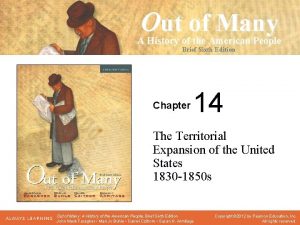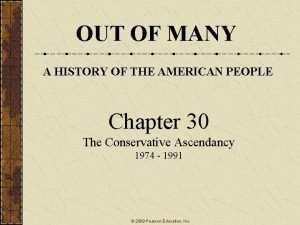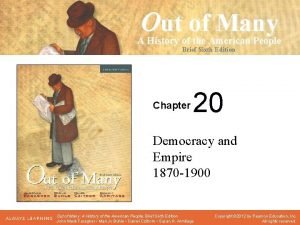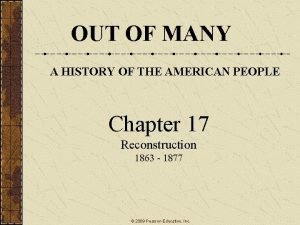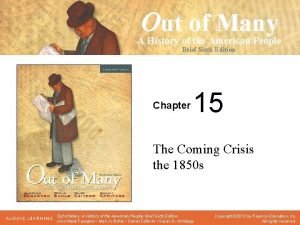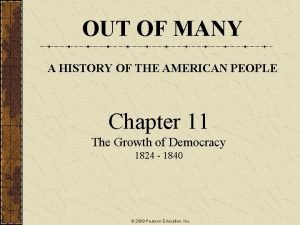Out of Many A History of the American










































































- Slides: 74

Out of Many A History of the American People Seventh Edition Brief Sixth Edition Chapter 10 The South and Slavery 1790 s-1850 s Out of Many: A History of the American People, Brief Sixth Edition John Mack Faragher • Mari Jo Buhle • Daniel Czitrom • Susan H. Armitage Copyright © 2012 by Pearson Education, Inc. All rights reserved.

The South and Slavery 1790 s-1850 s • • King Cotton and Southern Expansion The African American Community Freedom and Resistance The White Majority Planters The Defense of Slavery Conclusion

A Slave auction in Virginia. 1861

Chapter Focus Questions • How did attitudes in the South toward slavery change after the invention of the cotton gin? • What is a “slave society”? • What was life like for slaves in the American South? • What role did religion play in African American slave communities?

Chapter Focus Questions (cont’d) • What were the values of yeoman farmers? • Who were the planter elite? • Why was the white South increasingly defensive after 1830?

North America and Marion, AL

Cotton Communities in the Old Southwest • Samuel Townes rebelled and moved to Alabama to create a plantation. • Panic of 1837 devastated his ambitions. • White community support was weak due to rapid expansion westward. • African Americans built their own, stronger communities, often invisible to whites.

King Cotton and Southern Expansion

Model of Eli Whitney’s cotton gin, invented in 1793

MAP 10. 1 The South Expands, 1790– 1850

Cotton and Expansion into the Old Southwest • Eli Whitney’s and Catherine Greene’s cotton gin made cultivating short-staple cotton profitable, revolutionizing the Southern economy. • After the War of 1812 Southerners expanded into Western Georgia, Alabama and Mississippi, driving out the Indians who already lived there,

Cotton and Expansion into the Old Southwest (cont'd) • A generation later they poured into Louisiana and Texas.

Cotton and Expansion into the Old Southwest (cont'd) • Each surge of expansion ignited a speculative frenzy. • The expansion of cotton was concentrated in the rich soil sections of the South known as the black belt. • The expansion of cotton cultivation led to an expansion of slavery.

FIGURE 10. 1 Cotton Exports as a Percentage of All U. S. Exports, 1800– 1860

Slavery the Mainspring—Again • Cotton was exported to Britain in increasing quantities while also supplying Northern textile mills. • Southern slavery supported Northern industrialization, while Northern businesses provided insurance and shipping services. • Because of its importance, cotton became the “King” of the American economy.

A Slave Society in a Changing World • The growth of the cotton economy committed the South to slavery. • While Northern industry expanded, the economy of the South lagged behind. • In other parts of the nation, attitudes toward slavery were changing. • Slave states were losing their political dominance as population shifted.

MAP 10. 2 Cotton Production and the Slave Population, 1820– 60

Slaves, dressed in new clothing, lined up outside a New Orleans slave pen for inspection by potential buyers

The Second Middle Passage: The Internal Slave Trade • The cotton boom caused a huge increase in the internal slave trade. • Slaves were chained, penned and treated like livestock in Natchez and New Orleans markets. • The size of the slave trade made a mockery of Southern claims of benevolence.

MAP 10. 3 Internal Slave Trade, 1820– 60

The African American Community

Slave quarters built by slave owners

The Mature American Slave System • Congress banned the international slave trade in 1808 so the South relied on natural increase and the internal slave trade. • The slave population grew from 700, 000 in 1790 to 4 million in 1860. • Slavery became increasingly concentrated on larger farms and plantations.

The Mature American Slave System (cont’d) • By law, slaves were property with no protection from abuse. • Masters nonetheless learned to deal with slave families and the church, two key institutions of African American life.

The Growth of the Slave Community • The growth of the slave population was due to the high fertility rate of African American women. • Health remained a life long issue for slaves and pregnant women were usually malnourished. • Slaves were more at risk due to poor living conditions and lived shorter lives than whites.

From Cradle to Grave • Slavery was a life long labor system. • Southern slave owners claimed that taking care of the slave was an act of benevolence. • Black children had no schooling. • Blacks learned to adapt to whites’ expectations, with malingering and sabotage to slow the pace of work, taking advantage of white prejudice.

FIGURE 10. 2 Distribution of Slave Labor, 1850

Field Work and the Gang System of Labor • 75 percent of slaves were field workers; 55 percent were engaged in cotton growing. • Most slaves worked in gangs of 20 to 25 from first light to dusk. • Work was extremely tedious. • Slaves aged fast in this regime due to poor diet and heavy labor.

House Servants and Skilled Workers • One third of female slaves in Virginia worked as house servants by 1800. • House servants were better fed and clothed and had access to more information. • The most unpleasant thing was the constant presence of white people. • Other slaves learned skilled trades, but their labor profited only their masters

House Servants and Skilled Workers (cont'd) • In Southern towns, slaves did work of Northern free laborers.

Thomas Jefferson used this revolving bookstand with five adjustable bookrests at Monticello.

Slave Families • Slave marriages were: § not recognized by law, § frequently not respected by masters, § a haven of love and intimacy for the slaves. • Parents gave children a supportive and protective kinship network. • Slave families were often split up.

Slave Families (cont'd) • Separated children drew upon supportive networks of family and friends, “uncles” and “aunts” replacing distant parents.

African cultural patterns persisted in the preference for night funerals and for solemn pageantry and song

Freedom and Resistance

Harriet Tubman

African American Religion • Slaves although not permitted to practice African religions, survivals worked their way into the slaves’ folk culture. • The first and second Great Awakenings introduced Christianity to many slaves. • In the 1790 s, African American churches began emerging. • Whites hoped religion would make the slaves obedient.

African American Religion (cont'd) • Slaves found a liberating message that strengthened their sense of community and offered them spiritual freedom.

Other Kinds of Resistance • White Southerners did everything they could to keep blacks from escaping. • “Running away nearby” and hiding in the swamps or woods for about a week and then returning was more common. • Harriet Tubman became a folk hero for her role in leading slaves to freedom.

Other Kinds of Resistance (cont'd) • Even failed rebellion threatened the slave system and warned masters of the danger of discontent.

Badges

Slave Revolts • Gabriel Prosser and Denmark Vesey organized conspiracies to attack whites (but failed) § Richmond (1800) / Charleston (1822) • Nat Turner led most famous slave revolt in Southampton County, Virginia in 1831 • Turner used religious imagery to lead slaves as they killed 55 whites.

Slave Revolts (cont'd) • After Turner’s revolt, white Southerners were reminded by the threat of slave insurrection that only force kept African Americans enslaved.

The moment, almost two months after the failure of his famous and bloody slave revolt, when Nat Turner was accidentally discovered in the woods near his home plantation

Free African Americans • By 1860, there were nearly 250, 000 free African Americans in the South, mainly working as tenants or farm laborers. • In cities, free African American communities flourished but had a precarious position as their members lacked basic civil rights. • All free Africans challenged Southern assumptions of white superiority.

The White Majority

The Tullie Smith house

Poor White People • Between 30 to 50 percent of southern whites were landless. • These poor whites lived a marginal existence as laborers and tenants. • They engaged in complex and sometimes clandestine relations with slaves. • “Poor white trash” seemed to blur the lines between slave and free, but even poor whites upheld notions of their supremacy.

Southern “Plain Folk” • Two-thirds of all southern whites lived in non-slaveholding families. • Most yeomen were self-sufficient farmers. • The strong sense of community was reinforced by close kin connections and bartering.

Southern “Plain Folk” (cont’d) • Some yeomen hoped to acquire slaves themselves, but many were content with self sufficient non-market agriculture. • Yeomen supported slavery because they believed that it brought them higher status. • The economic “freedom” that whites cherished rested on slavery.

The Middling Ranks • A commercial middle class of merchants, bankers, factors, and lawyers: § arose to sell southern crops on the world market, § lived in cities that acted as shipping centers for agricultural goods.

The Middling Ranks (cont'd) • Some Southern industry—textiles in South Carolina, the Tredegar Iron Works in Richmond—developed, but most whites saw business and trade as lacking true independence.

Planters

The gang system used in cotton cultivation

FIGURE 10. 3 Slaveholding and Class Structure in the South, 1830

Small Slave Owners • Most slaveholders owned only a few slaves. • Bad crops or high prices that curtailed or increased income affected slave-holding status • Middle class professionals had an easier time climbing the ladder of success, but often then bought or married into the slave -owning elite.

The Planter Elite • Most slaveholders inherited their wealth but sought to expand it. • As slavery spread so did the slave-owning elite. • The extraordinary concentration of wealth created an elite lifestyle. • A handful of planters owned 1, 000 to 2, 000 slaves and built palatial mansions.

Creating a Plantation Ideology • Most wealthy planters lived isolated lives. • Some planters cultivated an image of gracious living in the style of English aristocrats, but plantations were large enterprises that required much attention to a variety of tasks. • Plantations aimed to be self-sufficient.

Creating a Plantation Ideology (cont'd) • While men cultivated an paternalistic ideology, the plantation mistress bore the burden of supervising the slave and free household.

Coercion and Violence • The slave system rested on coercion and violence. • Slave women were vulnerable to sexual exploitation, though long-term relationships developed. • Children of master-slave relationships seldom were publicly acknowledged and often remained in bondage.

Coercion and Violence (cont'd) • Violence was used by men and women alike to control slaves. • The humanity of the system owed more to slaves than to masters.

“Gordon under Medical Inspection”

The Defense of Slavery

Developing Proslavery Arguments • Pro-slavery arguments § justifications in the Bible or classical Greece and Rome, § the Constitution’s recognition of slavery • The Missouri Compromise alarmed most southerners. • Denmark Vesey’s conspiracy was blamed on Northern anti-slavery sentiment by South Carolinians.

Developing Proslavery Arguments (cont'd) • After Nat Turner’s Rebellion, any criticism of slavery was seem as a threat to the South.

After Nat Turner • In the 1830’s, southern states began to barricade themselves from outside antislavery propaganda such as William Lloyd Garrison’s Liberator. • In 1836, southerners introduced a “gag rule” in Washington to prevent congressional consideration of abolitionist bills.

After Nat Turner (cont'd) • John Henry Hammond, John C. Calhoun and George Fitzhugh defended slavery as a positive good, superior to Northern free labor.

MAP 10. 4 Population Patterns in the South, 1850

Changes in the South • Growing cost of slaves § percentage of slaveholders declined and class divisions widened • The slave system disintegrated in southern cities. • Economic changes adversely affected poor whites and yeomen.

Changes in the South (cont'd) • North Carolinian Hinton Rowan Helper denounced slavery in 1857, but his book was published in New York. • Reliance on slavery made the South unwilling to change or compromise.

Conclusion

The South and Slavery 1790 s-1850 s • The spread of cotton cultivation brought new states into the Union but fastened the slave labor system on the South. • Southerners denied their dependence on slave labor and clung white supremacist ideology.

The South and Slavery 1790 s-1850 s (cont’d) • As the South closed ranks against criticism of slavery, Southern leaders became more rigid and unwilling to compromise in national politics.

Chronology
 Out of many a history of the american people
Out of many a history of the american people Shot me out of the sky one direction
Shot me out of the sky one direction Othello put out the light
Othello put out the light Meaning of out out by robert frost
Meaning of out out by robert frost Outta sight outta mind quotes
Outta sight outta mind quotes Out out frost analysis
Out out frost analysis Loto safety talk
Loto safety talk Onomatopoeia in out out
Onomatopoeia in out out Lily gulledge
Lily gulledge Self righteous
Self righteous Lock out tag out pictures
Lock out tag out pictures Out, damned spot! out, i say!
Out, damned spot! out, i say! Henri fayol parents
Henri fayol parents Makna out of sight out of mind
Makna out of sight out of mind Log out tag out deutsch
Log out tag out deutsch Hát kết hợp bộ gõ cơ thể
Hát kết hợp bộ gõ cơ thể Ng-html
Ng-html Bổ thể
Bổ thể Tỉ lệ cơ thể trẻ em
Tỉ lệ cơ thể trẻ em Chó sói
Chó sói Tư thế worm breton là gì
Tư thế worm breton là gì Chúa yêu trần thế alleluia
Chúa yêu trần thế alleluia Môn thể thao bắt đầu bằng chữ f
Môn thể thao bắt đầu bằng chữ f Thế nào là hệ số cao nhất
Thế nào là hệ số cao nhất Các châu lục và đại dương trên thế giới
Các châu lục và đại dương trên thế giới Cong thức tính động năng
Cong thức tính động năng Trời xanh đây là của chúng ta thể thơ
Trời xanh đây là của chúng ta thể thơ Mật thư tọa độ 5x5
Mật thư tọa độ 5x5 Phép trừ bù
Phép trừ bù Phản ứng thế ankan
Phản ứng thế ankan Các châu lục và đại dương trên thế giới
Các châu lục và đại dương trên thế giới Thể thơ truyền thống
Thể thơ truyền thống Quá trình desamine hóa có thể tạo ra
Quá trình desamine hóa có thể tạo ra Một số thể thơ truyền thống
Một số thể thơ truyền thống Bàn tay mà dây bẩn
Bàn tay mà dây bẩn Vẽ hình chiếu vuông góc của vật thể sau
Vẽ hình chiếu vuông góc của vật thể sau Thế nào là sự mỏi cơ
Thế nào là sự mỏi cơ đặc điểm cơ thể của người tối cổ
đặc điểm cơ thể của người tối cổ V cc
V cc Vẽ hình chiếu đứng bằng cạnh của vật thể
Vẽ hình chiếu đứng bằng cạnh của vật thể Fecboak
Fecboak Thẻ vin
Thẻ vin đại từ thay thế
đại từ thay thế điện thế nghỉ
điện thế nghỉ Tư thế ngồi viết
Tư thế ngồi viết Diễn thế sinh thái là
Diễn thế sinh thái là Dot
Dot Bảng số nguyên tố
Bảng số nguyên tố Tư thế ngồi viết
Tư thế ngồi viết Lời thề hippocrates
Lời thề hippocrates Thiếu nhi thế giới liên hoan
Thiếu nhi thế giới liên hoan ưu thế lai là gì
ưu thế lai là gì Hổ đẻ mỗi lứa mấy con
Hổ đẻ mỗi lứa mấy con Khi nào hổ mẹ dạy hổ con săn mồi
Khi nào hổ mẹ dạy hổ con săn mồi Hệ hô hấp
Hệ hô hấp Từ ngữ thể hiện lòng nhân hậu
Từ ngữ thể hiện lòng nhân hậu Thế nào là mạng điện lắp đặt kiểu nổi
Thế nào là mạng điện lắp đặt kiểu nổi One out of many naipaul summary
One out of many naipaul summary How many words can you make out of deoxyribonucleic acid
How many words can you make out of deoxyribonucleic acid Many sellers many buyers
Many sellers many buyers Er model
Er model Bookstore database design
Bookstore database design Erm erd
Erm erd Unary many to many
Unary many to many Erd ratio
Erd ratio Unary many to many
Unary many to many Many-to-many communication
Many-to-many communication Sqlbi many to many
Sqlbi many to many Ternary relationship example
Ternary relationship example Many sellers and many buyers
Many sellers and many buyers British army history jeopardy
British army history jeopardy Latin city model
Latin city model History alive pursuing american ideals
History alive pursuing american ideals Esl american history
Esl american history U.s. history semester 2 final exam
U.s. history semester 2 final exam
